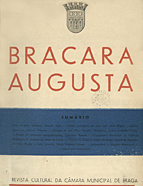

................................
Not forgetting the period between 1935 and 1949, more than 500 Portuguese and foreign authors contributed to Bracara Augusta , a collaboration that resulted in over 900 published titles, revealing the high scientific and cultural level of its participants, such as António Álvaro Dória (1902-1990), Marcello Caetano (1906-1980), Avelino Jesus da Costa (1908-2000), José Pedro Machado (1914-2005), Francisco José Veloso (1918-2009), Raúl de Almeida Rolo (1922-2004), Amadeu Torres (1924-2012), Fernando Castelo-Branco (1926-), A. H. de Oliveira Marques (1933-2007), Humberto Baquero Moreno (1934-2015), José Mattoso (1933-), José Marques (1937-) and Aurélio de Oliveira (1944-), to name but a few historians from a long list of academic figures.
Among the foreign authors who actively participated in Bracara Augusta , the contributions of Galician philologist Ramon Otero Pedrayo (1888-1976), Galician journalist and writer Luis Bouza-Brey Trillo (1905-1980), the Galician priest and historian Enrique Chao Espina (1908-1989), the American historian Robert Chester Smith (1912-1975), Galician doctor and historian Manuel Rubén García Álvarez (1915-1980) and Belgian medievalist Charles Verlinden (1907-1996), among other internationally renowned figures.
In the scientific array developed by the contributors to Bracara Augusta , reflections of a specifically historiographical nature did not feature prominently in its pages, although we can point to some authors that reflected on historiography, even if such exercises did not reflect the editorial dictates and dissemination aims of this publication. In this context, we would like to mention the particular contributions of José Baptista Barreiros (1893-1965), Mário Brandão (1900-1995), Bertino Daciano Rocha da Silva Guimarães (1901-1965), António da Silva Rego (1905-1986), Sérgio da Silva Pinto (1915-1970), Vitorino de Sousa Alves (1915-2002), Cândido Lima (1939-) and Luís A. de Oliveira Ramos (1939-), without neglecting other exercises where historiographical reflection found some expression.
This work is financed by national funds through FCT - Foundation for Science and Technology, I.P, in the scope of the projects UIDB/04311/2020 and UIDP/04311/2020.
